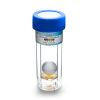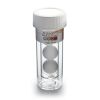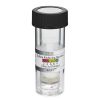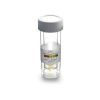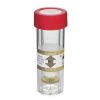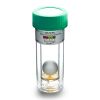Hach Fluorescing Pseudomonas BART Test
Features
- Simple yet effective method for monitoring the population size and/or activity of specific groups of bacteria
- Easy to use, requiring no elaborate or costly equipment and no specialized training
- Effective and afforable tests are easy to interpret and can be performed at room temperature in virtually any environment
- Free ground shipping
- Expedited repair and warranty service
- Lifetime technical support
- More
Overview
The Hach Fluorescing Pseudomonas BART test is a diagnostic tool that helps identify the presence and aggressivity of various bacteria. Pseudomonad bacteria are often present in waters that contain oxygen and are rich in organic pollutants (e.g., gasoline, jet fuel, solvents). The presence of pseudomonad bacteria may indicate that aerobic biodegradation is occurring, and biofouling may also be happening within the system being tested. Some pseudomonad bacteria that produce fluorescent pigments (pigments that glow in ultraviolet light) may be a hygiene risk. The faster that clouding and fluorescence happens, the more aggressive the pseudomonad bacteria.
In The News
From Paddles to Phytoplankton: Studying Vermont’s Wildest Lakes
For six months of the year, Rachel Cray, a third-year PhD student at the Vermont Limnology Laboratory at the University of Vermont, lives between a microscope and her laptop, running data. For the other six months, she is hiking and canoeing four of Vermont’s lakes, collecting bi-weekly water samples. Cray studies algal phenology across four lakes in Vermont, US, that have low anthropogenic stress—or in other words, are very remote. Funded by the National Science Foundation Career Award to Dr. Mindy Morales, the lakes Cray researches part of the Vermont Sentinel Lakes Program, which studies 13 lakes in the area and, in turn, feeds into the Regional Monitoring Network, which operates in the Northeast and Midwest US.
Read MoreReimagining Water Filtration: How Monitoring and Science Enhance FloWater Filtration Systems
Over 50% of Americans think their tap water is unsafe , according to the Environmental Working Group (EWG). Other recent surveys have found that number to be as high as 70% of persons surveyed. Whether due to increased public awareness of water quality issues or confusion about how municipal water sources are regulated, there is a clear distrust of tap water in the United States. According to industry expert Rich Razgaitis, CEO and co-founder of the water purification company FloWater, this issue creates a damaging cycle. Razgaitis explained that the health and environmental problems associated with contaminated water aren’t the only issues. As people become increasingly aware that some tap water is unsafe, they resort to bottled water.
Read MoreMonitoring New Hampshire’s Aquatic Ecosystems: Continuous Data Collection in the Lamprey River Watershed
New Hampshire’s aquatic ecosystems provide a range of ecosystem services to the state and region. Resources and services like clean water, carbon storage, climate regulation, nutrient regulation, and opportunities for recreation all depend on New Hampshire’s aquatic ecosystems remaining healthy. Jody Potter, an analytical instrumentation scientist at the University of New Hampshire (UNH), is studying these aquatic ecosystems in hopes of developing an improved understanding of ecosystem services and their interactions with climate change, climate variability, and land use changes. [caption id="attachment_39799" align="alignnone" width="940"] Aquatic sensors in the Merrimack River in Bedford, NH, with I-293 in the background.
Read More


